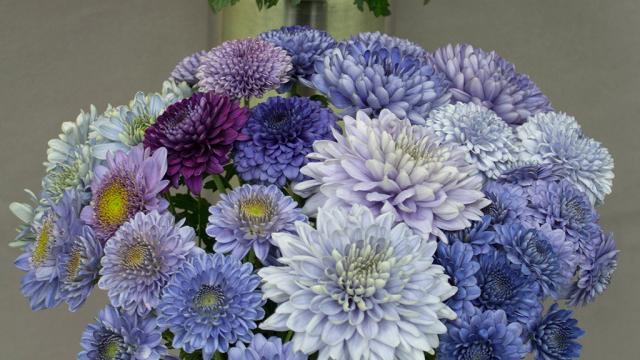Genetically engineered ‘blue’ chrysanthemums. Credit: Science Advances
In nature, blue is much rarer than you might think. Sure, the sky is blue when the weather’s nice, and so is the ocean. But the vast majority of plants and animals are incapable of making blue pigment. Brilliantly-coloured peacocks appear blue not because their feathers are coloured that way, but because of how they reflect light. Less than 10 per cent of the world’s 280,000 flowering plants produce blue flowers, which may be why they’re often a symbol of the unattainable in folklore and literature.
But for decades, scientists have sought to use engineering to overcome the limitations of nature, and create truly blue flowers. On Wednesday, a group of Japanese scientists announced a first: chrysanthemums engineered to express two different flower genes, and a hue of blue.
“Chrysanthemums, roses, carnations and lilies are major floricultural plants, [but] they do not have blue flower cultivars,” Naonobu Noda, lead-author of the study and scientist at Japan’s National Agriculture and Food Research Organisation, told Gizmodo. “None has been able to generate blue flower cultivar by general breeding technique.”
To turn typically red or pink chrysanthemum blooms blue, Noda and his colleagues engineered the flowers to express two genes from butterfly peas and Canterbury bells linked to the blue coloration of those flowers. This approach resulted in flowers that appeared within the blue spectrum. This resultant colour, they discovered, was the work of “co-pigmentation,” an intra-flower chemical interaction that they hope will also help turn other popular flowers blue.
Suntory, a Japanese conglomerate better known for its alcoholic beverages, has long sought to engineer blue flowers. In 2009, after two decades of research, it released the world’s first “blue” rose, a flower that seemed more pale purple than blue. Aesthetes may note that the new “blue” chrysanthemums seem more like shades of violet, lavender and eggplant.

Genetically engineered ‘blue’ chrysanthemums. Credit: Science Advances
“Their flowers are like a cool lavender at best,” said Sebastian Cocioba, an artist and biohacker who has been working to engineer his own blue rose. “I could never feel comfortable calling that blue.”
And yet, Suntory’s rose, the “Applause” is the closest thing to a true blue rose yet. Ditto the chrysanthemums, which technically fall within the blue or violet-blue colour groups as designated by the Royal Horticultural Society. They may not be cerulean, but Suntory’s chrysanthemums are still a major feat of engineering. Chrysanthemums do not produce what are known as delphinidin-based anthocyanins, pigments that are responsible for shades of blue in certain flowers. Noda and his team were able to introduce those pigments into the flower’s genome via genes from butterfly peas and Canterbury bells, and coax the flowers into expressing them.
There is a major market demand for such laboratory creations. When it debuted in Japan, Suntory’s blue rose was sold for 10 times the price of normal roses. Chrysanthemums are the second best-selling flowers after roses in the world. Novel, engineered blue flowers, Noda said, he expects will drastically expand the desire to buy flowers.

Suntory’s ‘blue’ rose. Image: Suntory
Still, the scientists are upfront that these flowers appear more purple than blue.
The blue colour development of flowers is well-studied, and flowers get to that colour in several ways. Noda and his team chose the method they believed most likely to work — copigmentation. Other methods, like modifying pH levels, they hypothesized might destabilize the flower’s cells. But, since the flowers did not turn out as blue as researchers expected, there might be more to the colour blue in flowers than previously realised, they wrote in their paper.
In the end, perhaps the amount of blue in nature is something we can’t simply engineer our way around.
“There is ideas to make it more blue,” said Noda. “However, as there is no [single] gene to realise it, it may be difficult.”
